You may not find this terribly rewarding unless you're included here, so this is a good time for casual and random browsers to turn back before they get too caught up in the sweep and majesty of the proceedings and can't let go.
21 October 2021 in beatific weather so far

Stepping out our front door -- that's the other side of E. Frederick St. in semi-early sunlight.

Our photos claim that this was taken at 7:15 a.m., which is highly unlikely -- they're probably still on Wisconsin Central Time. That's a barbecue place tucked into the centre there.

This is N. Central Ave., with road resurfacing (and attractive new brick sidewalks) that's been going on for probably 18 months. To be fair, we understand that they are installing sophisticated flood warning devices into the road somehow. This is a notoriously flood-prone street -- there is a creek running down from Gypsy Hill Park, the 'Gum Spring Branch', to join the infamous Lewis Creek under the main carpark near the train depot, and along most of this street it's buried under the buildings, peeking out from time to time between them.
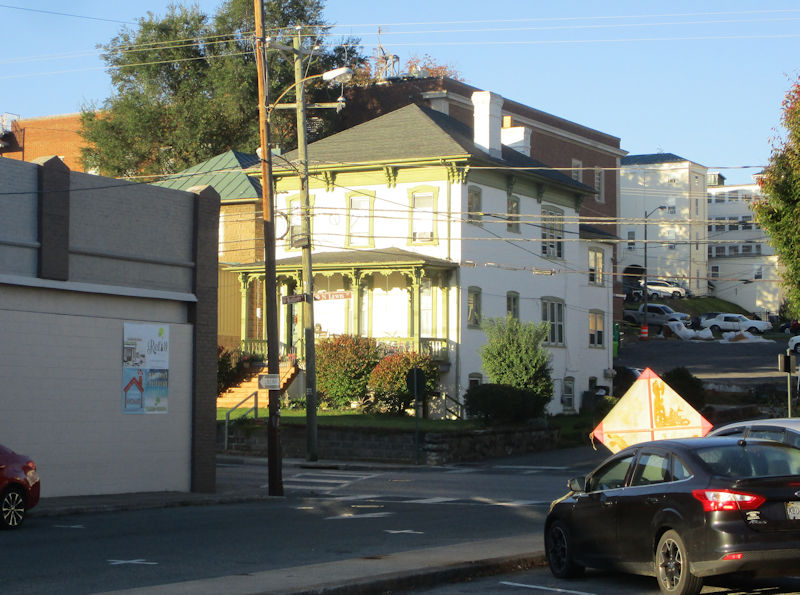
A colorful old place on N. Lewis, one block farther over to the west, and the Stuart Hall Academy up the street a ways.

N. Lewis St has a long line of interesting houses, well kept up from a former era.

Unintelligible at this point

Another interesting building, likely with a complicated floorplan. (We're pleased to report that Hartless won the recent election for County Sheriff.)

This is the 7 a.m. (or 8 a.m.) breakfast line at the local Hardees. Yum.
(If they could wait for lunch time, they could qualify for a Hardee's 'Double Bacon Beast Burger'. Yum Yum.)

Fall colors on Frederick St. It's across N. Augusta Street from our house on E. Frederick, but this is actually W. Frederick. That's life in the city!
A visit to Staunton's historic Wharf District
2 hours later, 21 October 2021 (i.e., 9:30 a.m., or 10:30 a.m.)

Our next door neighbor up E. Frederick St is the 'small hotel' Frederick House Hotel, with 20 rooms sprinkled amongst this and four nearby satellite houses, but it is this Greek Revival mother ship that is said to have been built in the 1830s, with some enlargements through to the 1920s.

Someone (or something) is attempting to cross New Street without risking the traffic. Find him (or it).

Ingenious, brave, and agile.

A quaint and interesting small used bookstore, tucked in behind the County Courthouse -- one of the few proprietors who held out when the bad guys tried to buy up properties through here for a huge, awful new courthouse (an underhanded plan which was abandoned in the end).

A little private park for the public, offered in memory of Mevluda Tahirovic

That's a commodious public parking building, the New Street Garage, sort of stuck on the back of the Hotel 24 South. We think it's extremely attractive for a public facility.
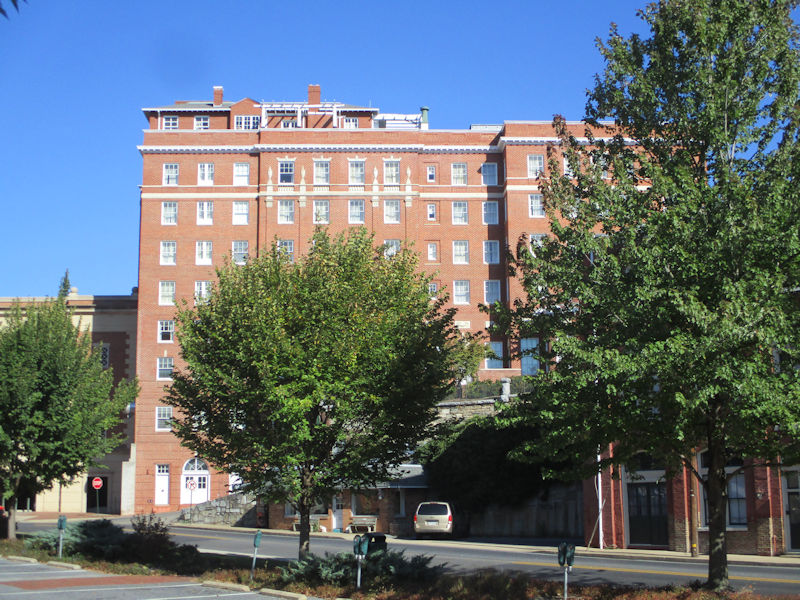
And just alongside is the 24 South Hotel, an uncommon sort of name that was invented recently when its longtime name, the 'Stonewall Jackson Hotel', began to seem unhelpful. It was built in 1924, restored in 2005, and renovated in 2018. The public spaces inside are very beautiful (haven't seen the rooms).

That's the former White Star Mills from up New Street, with Lewis Creek emerging from under all the architecture just beyond those traffic lights.

Just across the street, Johnson St., that's the justly infamous Lewis Creek, emerging from under buildings and the huge downtown carpark to burble along on its way to the South Fork, the Shenandoah, the Potomac and Chesapeake Bay. When it decides to flood, it's a superbly unwelcome event. (The towers in the right background are grain elevators from the 1950s, we're told, of which there were once many.)
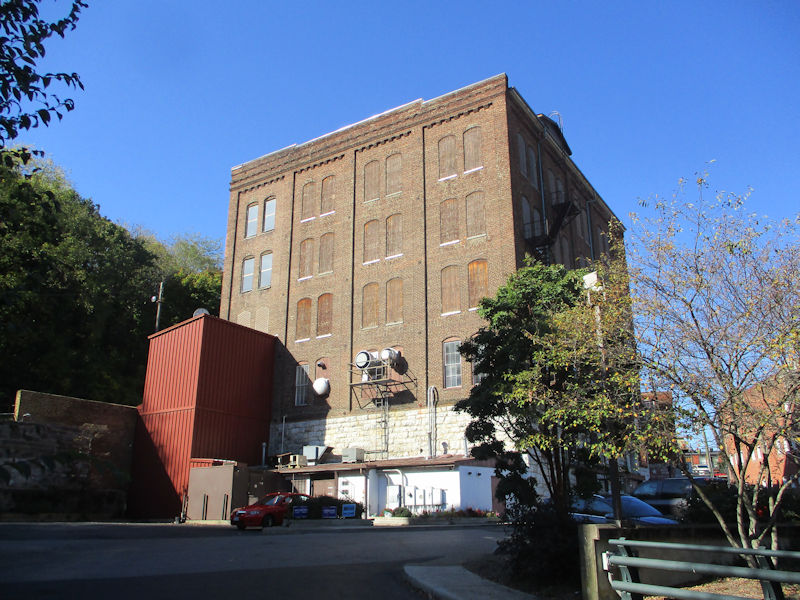
And there's one side of the former White Star Mills, backing onto the rail tracks, a trapezoidal shape, built in about 1892, the largest of many long-gone mills in town. It closed in 1966, but is now occupied by . . .

. . . the very satisfactory Mill Street Grill.

Looking up South and North New Street from Mill Street and its worthy Grill.
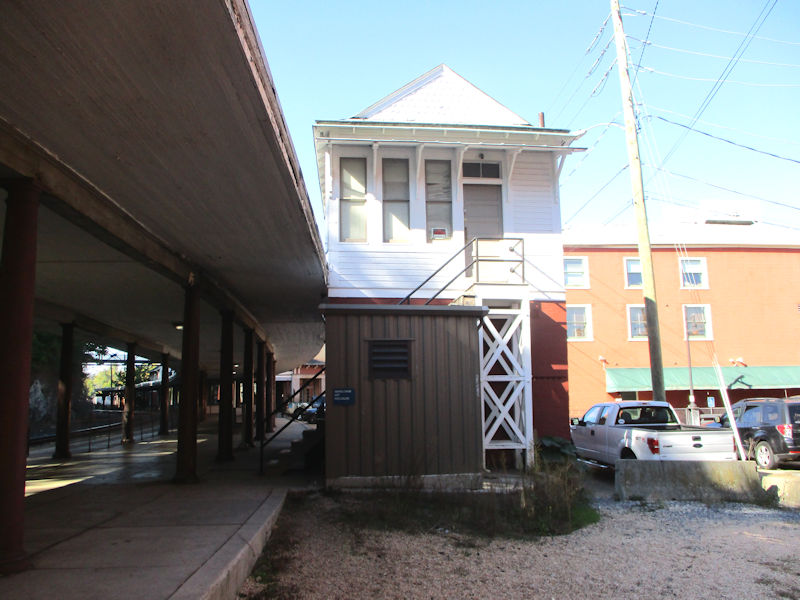
That is the early railroad 'Signal House', from about 1886, now evidently used as an unstaffed waiting room an hour before train arrivals.

In 1854, the Virginia Central Railroad pushed its east-west line through from Charlottesville past Staunton and westward, crossing the main north-south road up the Shenandoah Valley, the ancient 'Valley Pike', and thus making Staunton the major trade crossroads in the region.

The railroad company built to serve the travelers the American Hotel in the mid-1850s, which is presently well stocked with commercial enterprises, including the Serendipity Java Bar and Eatery, the American Hotel Banquet Room, a law firm and some investment advisors, and a beauty salon (maybe two). 'A key claim to fame was the 1869 overnight stay by President and Mrs. Ulysses S. Grant, who emerged from the balcony while being serenaded by the Stonewall Brigade Band outside' (source, tho' most other sources date that to 1874).
Traditionallly, Grant at Appomattox had allowed the Stonewall Jackson regimental brigade's marching band to keep their instruments, so they were pleased. The Stonewall Brigade Band still exists, HQ'd out at Gypsy Hill Park, and their own website debunks this pleasant legend.

Approaching the present railroad depot along the concourse . . .

. . . and looking northward up Augusta Street, the St Francis Catholic Church's steeple peeking over the top

The first depot here was built in 1854, but in 1864 Gen. Hunter's Union troops came up the Valley and destroyed all of Staunton's transport and communications infrastructure, without however damaging the rest of the town, we're told. Thus the American Hotel and some of the earlier warehouses have survived with appropriate upkeep.

The Warehouse District (called the 'Wharf District') across Middlebrook Ave in front of the station

The wrecked depot was replaced in 1872 and served admirably until it was knocked down by a runaway train in 1890, worse luck.

The present depot was designed by Staunton's legendary T. J. Collins in 1902, in a 'Bungalow Style' (we're told), and evidently opened for business in 1906. It was useful into the 1960s but then let go idle until a necessary renovation more recently, after which it was occupied by a restaurant for a while. Most recently, since we arrived two years ago, it was recommissioned as a wedding and events facility, with a promising future, until the covid hit, and in the end the enterprise was given up in spring 2021. It's open for leasing now.

The length of Middlebrook Ave through the historic Wharf District, built during the boom years of 1870-1910, when it was the heart of the town's trading district for farmers, grocers, and wholesalers supplied directly from the train deliveries.

That's the length of ancillary freight buildings extending above Middlebrook along the rail tracks westward from the depot.

And that's a steel truss bridge built over the tracks to Sears Hill on the other side, first in 1905 and restored by public subscriptions 2010-2016. We'll take a closer look in a few minutes.

There are a small number of artisanal craft shops along here, chiefly to do with textiles evidently. The large wooden building in the foreground was the freight office, erected in 1904.

A view of some well-restored inhabitants of Middlebrook Ave in the Historic District, featuring an insurance agency, investments advisors, a storefront American branch of the Anglican Church (the yellow façade), a pet supply store, etc.

Centrally along Middlebrook in front of the rail station siding is Gibson's Warehouse, designed by T. J. Collins and apparently built between 1904 and 1909, serving as a hay and fertilizer store and then for farm implements. It fell into disuse and narrowly escaped demolition during the city's ill-advised Urban Renewal schemes of the 1980s, but it has been thoroughly refashioned as a boutique hotel of four rooms, with evocative period trappings but all modern spaces and amenities, by the gentleman who owns the Byers Street Bistro facing out the other side of the building onto the municipal carpark. It opened in October 2018. (Source)

These are former warehouses at the far end of this part of Middlebrook Ave. (which continues well beyond the historic Wharf, at least 26km, in fact, well past the village of Middlebrook itself, where it then transforms into the Brownsburg Pike, US252, etc., etc., until it gets to Lexington, VA).
Early plans evidently show that 'gangplanks' (or 'walkways') extended from railroad sidings on this side over the road to those second story loading doors for transferring goods by carts directly up from the rail cars. (They look like the 4th & 5th story doors on the front of houses in Amsterdam for hoisting goods up from the street by pulleys.)

The farther end of the row of depot storage facilities, much of it now occupied by the 'DPO' Depot Grille.

In front of those facilities, as indicated by those souvenir rail cars, there were sidings off the main line for offloading cargo directly into these sheds or over gangplanks to the warehouses across the street.

That's the extremely popular Depot Grille (called 'DPO'), opened in 1990, the reception in the higher part with several open rooms extending to the left, and kitchen facilities along the back of those. A newer addition on the right includes a beautiful 40-foot Victorian bar imported from a luxury hotel in Albany.

We stroll round to the trackside for another brief look at things.

That's the concourse and the back of the main depot building, most recently renovated to create a wedding and events facility in about 2019, which . . .

. . . very unfortunately, was constrained to give up in April 2021, due to the covid effects on the business. It's available for leasing now.

Farther along the track, that's the back of the former freight office, now home of the Appalachian Piecework Antiques & Textile Studio.

Decommissioned rail cars, some or all of them still in use as extensions of the shops in the row of depot sheds.

That's us -- the Amtrak 'Cardinal' train stops here thrice a week in each direction, between New York City, Washington, D.C., and Charlottesville, and Chicago on the far end.

Formerly Rachel's Quilt Patch
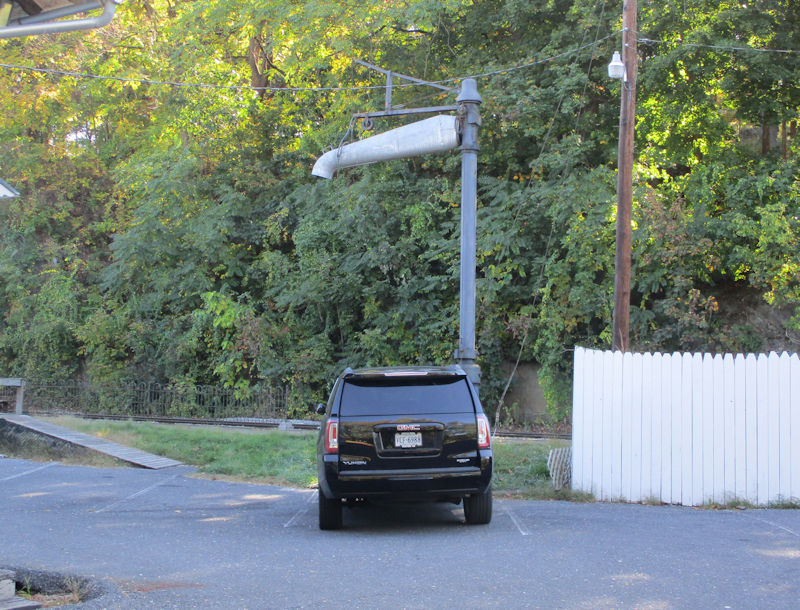
-- Fill 'er up.

Remains of the old cargo siding at the near end of the Depot Grille

That's the Middlebrook Ave row from the 1905 Sears Bridge, restored in recent years and leading up to the Sears Hill neighborhood.

The Sears Bridge

The rail track and concours, with the American Hotel and old White Star Mill behind

Downtown Staunton from the bridge, with the Clocktower on the left, Masonic building in the centre, St Francis Church to the right of that, and our Old Y condo just in front of the steeple

There's an observation platform just up the Sears Hill path from the bridge, featuring panels identifying all the best stuff as well as this Beyer lithograph from 1857.

That's the rear siding along the west end of the depot.

Back down to S. Augusta St, this former wholesale grocery company from ca. 1880, which faces down Middlebrook Ave past the depot, was entirely renovated in 1982 and now hosts law offices.

Just across the street, at 120 S. Augusta, this anomalous building, which is built directly over Lewis Creek, dates from 1876 and stands out in a city of brick buildings because the upper façade is made of 'pressed metal'.

Back around to the bottom of New Street, adjacent to the rail tracks, this building built ca. 1870 once specialized in making 'shirts, overalls & duck coats' on the premises. It was renovated in 1973, early in the city's progress on rehabilitating historic buildings for mixed-use development.

Forging back up New Street towards home, we pause to admire that old 'Second Empire style' (we're told) Eakleton Hotel, built in 1894, recently restored and presently the home of the R R Smith Centre for History & Art and some local historical fan clubs.

Cranberry's Grocery (for natural health foods) and Eatery (good sandwiches) is the oldest, or one of the oldest, surviving commercial establishments in town, built in either 1830 or 1758 (depending on your source), and has been through many incarnations, including a Chinese laundry, printers' shop, and taxi garage. It opened in 2003 and 'has been named Favorite Health Food Store in the Valley by The News Virginian'.

And so we're home from our walk, or almost so. That's the hind end of the Old Y condo across the carpark behind the Frederick House Hotel. (A short story: it's officially a pay carpark but the pay machine broke about 18 months ago and no one's figured out how best to replace it since then, so it's 'temporarily' still free now. It's been getting a bit harder to find a place here at some times of the day, as the freeness word has spread about, but all in all it's a great convenience for us. We just need to wriggle through that alley in the centre and slip in through our basement door.)
What's next, then? The Lake Sherando 'cliff trail' with some disappointing fall foliage
 Dwight Peck's personal website
Dwight Peck's personal website



























































